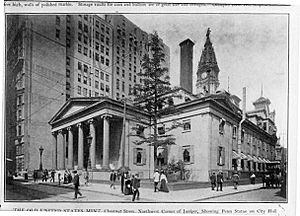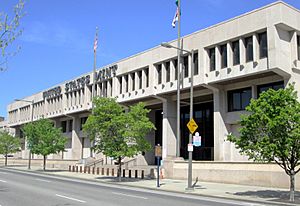Philadelphia Mint facts for kids
The Philadelphia Mint is a special factory where the United States makes its coins. It was created because the new country needed its own money and a way to show its national identity. The leaders of the United States, called the Founding Fathers of the United States, decided that having a national mint was very important after the country's rules, the Constitution of the United States, were approved.
On April 2, 1792, a law called the Coinage Act of 1792 was passed. This law officially created the United States Mint. At that time, Philadelphia was the nation's capital city. So, the very first mint building was built there. The Coinage Act of 1792 also set up a money system based on the dollar. It explained how much coins should weigh, what metals they should be made of, and how pure the metal needed to be. It also said that every United States coin must have a picture that represents "liberty" or freedom.
Contents
History of the Philadelphia Mint
First Mint Building (1792–1833)
David Rittenhouse, a famous American scientist, was chosen by President George Washington to be the first director of the mint. On July 18, 1792, Rittenhouse bought two pieces of land in Philadelphia. They were located at Seventh Street and 631 Filbert Street. The next day, workers began tearing down an old whiskey factory on the land.
Building work started on July 31. By September 7, the first building was ready for a special furnace used for melting metals. This melting house was the very first public building built by the United States government. A few months later, a three-story brick building was built facing Seventh Street. It was about 37 feet (11 m) wide and 33 feet (10 m) deep.
The basement of this building held the gold and silver for making coins. On the first floor, people would deposit and weigh the metals. This floor also had the press room, where coins were actually made. Mint officials had their offices on the second floor. The third floor was where the assay office was, which tested the purity of the metals. A photo from around 1908 shows that the words "Ye Olde Mint" and the year 1792 were painted on the front of the building.
Between the melting house and the Seventh Street building, a mill house was built. Horses in the basement would turn a machine called a rolling mill, which was on the first floor. This machine helped prepare the metal for coining.
In January 1816, a fire destroyed the melting and mill houses. The melting house was never fixed, and all melting work had to be done somewhere else. The mill house was completely rebuilt. It included a new steam engine in the basement to power the coin-making machines.
These three buildings made coins for the United States until 1833. In that year, the mint moved to a new, larger building. The land where the first mint stood was then sold. The first mint buildings were torn down between 1907 and 1911. Today, only a small plaque marks the historic spot.
Second Mint Building (1833–1901)
On July 4, 1829, the first stone was laid for the second mint building. It was located at Chestnut and Juniper Streets. William Strickland designed this new building. The second Philadelphia Mint was known as the "Grecian Temple." It was made of white marble and had classic Greek-style columns on the front and back.
This new mint was much bigger than the first one. It was about 150 feet (46 m) wide and 204 feet (62 m) deep. It opened in January 1833. At first, its production was slow because it used old machines from the first mint. To fix this, Franklin Peale was sent to Europe to learn about new coin-making technologies. He brought back new ideas and machines, which greatly improved how many coins could be made and how good they looked.
The second mint building was sold in 1902 and quickly torn down. When workers dug up the cornerstone that was buried in 1829, they found a jar inside. The jar held three coins, some old newspapers, and a scroll with information about the first mint and the creation of the second. Since 1914, a 19-story building called the Widener Building has stood on this site.
Third Mint Building (1901–1969)
The third Philadelphia Mint was built at 1700 Spring Garden Street and opened in 1901. William Martin Aiken designed it, and James Knox Taylor oversaw its construction. It was located close to the United States Smelting Company. In just one year, this mint made 501 million coins for the U.S. (which was 5 out of every 7 U.S. coins made). It also made 90 million coins for other countries.
This mint was a very large building, almost a full city block. It quickly became a famous landmark. It had a grand front that looked like an ancient Roman temple. Visitors could see seven beautiful glass mosaics designed by Louis Comfort Tiffany on a gold-backed ceiling. These mosaics showed how ancient Romans made coins. This mint building is still standing today, and much of its inside is still the same. The Community College of Philadelphia bought it in 1973. You can find more about its history on their website.
Fourth and Current Mint Building (1969–present)
The fourth and current Philadelphia Mint opened in 1969. It is located just two blocks from where the very first mint stood. Philadelphia architect Vincent G. Kling designed it. He also helped design other important buildings in the city. When it was built, it was the largest mint in the world. It kept this title as of October 2017.
The Philadelphia Mint today can make up to one million coins in just 30 minutes. It took the original mint three years to make that many coins! This mint also produces medals and awards for the military, government, and other public services. All the tools used to engrave and strike coins are made only here.
Uncirculated coins (coins not used in everyday buying and selling) made here have a "P" mint mark. Circulated coins (coins used every day) made before 1980 usually did not have a mint mark, except for some special coins like the Jefferson nickels from 1942–1945 and the 1979 Susan B. Anthony dollar coins. Since 1980, almost all coins made here have the "P" mint mark, except for cents (pennies), though 2017 cents do have the "P" mark.
Visitors can take tours of the mint. On the tour, you can see all the steps of coin making. There are also displays of old equipment. You walk on an enclosed path above the factory floor. Along the way, there are video stations where you can push buttons to watch videos about different parts of the coin-making process. Many of these videos were narrated by Harry Kalas, a famous announcer for the Philadelphia Phillies baseball team.
Thefts at the Mint
Over the years, there have been a few cases of theft at the Philadelphia Mint.
On August 19, 1858, two well-dressed thieves visited the mint on a tour. They used a fake key to open a display case. They took $265 worth of gold coins. However, these coins were very rare. The men were quickly caught when they tried to spend them in local stores.
In 1893, a clerk named Henry S. Cochran was found to have taken $134,000 in gold bars from the mint's vault. He had done this over 8 to 10 years. About $107,000 was found in his home and hidden in the mint's ventilation system.
In 2003, a woman named Joan Switt Langbord found ten very rare 1933 double eagle coins in a safe deposit box that belonged to her parents. These coins were never meant to be released to the public. When she tried to have them valued, the United States Department of the Treasury took them, saying they were stolen. After a long legal process, a jury decided in 2011 that these coins belonged to the U.S. government.
See also
 In Spanish: Casa de Moneda de Filadelfia para niños
In Spanish: Casa de Moneda de Filadelfia para niños





